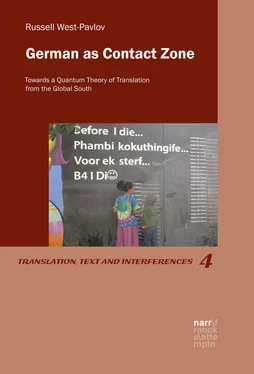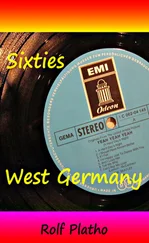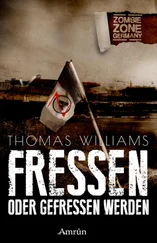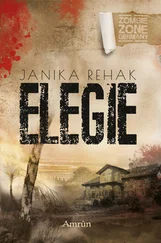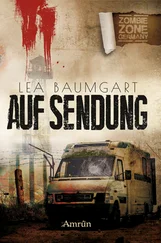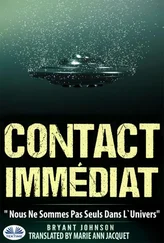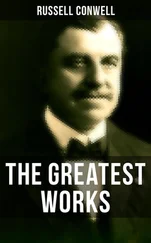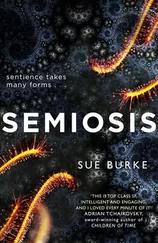We might discover that linguistic translation, far from being the ‘purest’ (non-metaphorical) form of translation, putatively contaminated and conceptually weakened by modish similes and conceptual derivatives, would itself be merely one participant in a gigantic network of metaphoric-metonymic transitions, transformations and metamorphoses to which one might assign the label of bíos , following the affirmative biopolitical project undertaken by Roberto Esposito (2008). Such a project has been assayed by Michel Serres’ Hermes III: La Traduction (1974) [ Hermes III: Translation ], a remarkable transdisciplinary essay that ranges across the fields of genetics, thermodynamics, politics, philosophy, painting and literature, showing how each of these areas displays operations that can be regarded as translation. Translating widely in the very hubris of its scholarly scope, Serres’ book offers a panorama of processes of translation in the broadest sense possible, of which literary-linguistic translation (and the human nature it supposedly demarcates from the natural world) is merely one realm of productivity.
This book seeks to take this idea seriously, investigating translation into (and occasionally out of) German literature as an exemplar of the ways in which translation might be seen as an index of larger process of cosmic and social creativity. Indeed, from this point of view, the German language itself would be seen as one strand in a bundle of languages linked by translative processes and indicative of social creativity. The German language thus comes to be understood, within this book, as a ‘contact zone’: a sector always already polylingual in itself, and blurred around its many borders at the points where it meets other languages. The notion of the ‘contact zone’ comes into the literary humanities via Pratt (1992: 6), who ‘borrow[s] the term “contact” … from its use in linguistics, where the term contact language refers to improvised languages that develop among speakers of different native languages who need to communicate with each other consistently, usually in the context of trade.’ In this book, I redirect it to its original socio-linguistic context, and the ‘original’ historical situation to which it refers, that of ‘exchange’. It is striking, however, even weird, that among the ‘literate arts of the contact zone’ listed by Pratt (1991: 37)—‘[a]utoethnography, transculturation, critique, collaboration, bilingualism, mediation, parody, denunciation, imaginary dialogue, vernacular expression’—translation does not figure, though her ‘transculturation’ might be a rough approximation. (In a similarly bizarre fashion, Genette [1997: 405] mentions translation as one of the ‘paratexts’ that he declines to deal with.) Alternatively, one might premise that ‘translation’ is absent from Pratt’s list because it is the all-encompassing, and thus invisible term that embraces all her ‘arts of the contact zone’. Such a lacuna is filled by Apter (2005), who converts the ‘contact zone’ into a ‘translation’ zone in reference to an emergent field of studies at the intersection between translation studies and comparative literature (compare Bassnett 1993: 138-61). Translation is the dynamic nexus of such interdisciplinary undertakings.
Following Apter’s example, I import the term into the very heart of German national identity, the language itself. As a ‘pluricentric’ language (Muhr, Marley, Kretzenbacher and Bissoonauth, eds 2015), one that is also plural at its centre, I regard German as a ‘contact zone’, a realm of constantly productive translations hitherto understood as irritating interferences and impurities to be suppressed rather than embraced and fostered. Pratt (1992: 6) notes that ‘[l]ike the societies of the contact zone, such languages are commonly regarded as chaotic, barbarous, lacking in structure.’ Even though the German language is usually characterized as highly structured, Pratt’s comment is immensely relevant, because ‘chaos’ can be read here not in its customary negative sense, but in the sense of non-linear material creativity known to ‘chaos theory’ (Ruelle 1993). In the latter usage, ‘chaos’ describes the unpredictable and therefore creative development of structures and systems as they interact with their environment.
We need to pursue this logic of the ‘translative contact zone’ further, however, turning it back upon the notions both of the ‘contact zone’ and of ‘translation’ themselves. In recent decades, scientific discourses have come to be seen as a subset of larger social, indeed geopolitical discourses, as in Bruno Latour’s Les Microbes: Guerre et paix (1984). But the frames for the sociological study of the sciences have shifted significantly in recent decades, taking in a larger, even planetary horizon today, and it would now be more accurate to see the planetary processes of creation as the total set, with geopolitics and its attendant discourses operating on them, to be sure—but more importantly, always within them (Rees 2018). Thus, by the same token, the translative operations worked within language would not stop at the borders of language, but would continue along multiple ‘lines of flight’ and ‘desire lines’ into manifold outlying regions of the natural world. As the gaze broadens to take in these extra-literary ramifications, however, a surprising inversion may become evident. In a recurrent ‘turning inside-out’ that is central to the vitalist re-envisioning of the world (Esposito 2008: 157-94) it transpires that the natural world is not the ‘outside’ of the ‘real’ business of translation. On the contrary, linguistic translation, significant though it may be within human history, turns out to be a province of cosmic creation, a secondary translation of primary translations of epic proportions.
The book addresses these issues by opening with the film I have just discussed, then turning to half-a-dozen examples of the translation of literary texts, before reflecting upon the very pragmatic space of the literary classroom, and finally returning to a visual example, a public-art mural in the form of a street-blackboard in Johannesburg, South Africa, to conclude its argument.
The final turn to pedagogy is one that is pre-empted by Sissako’s usage of the motif of a photograph showing the erstwhile Russian class in Rostov-on-Don—a semiotic marker so important in the film that, after numerous recurrences, it provides the closing image before the credits (Sissako 1997: 57:55). The photo of the class is evoked verbally for the first time during a telephone conversation between Dramane/Sissako and his teacher Natalia Lvovna, when he asks her to send it to him as an aid to finding Baribanga (ibid: 5:55). The first glimpse of the photo comes five minutes later (ibid: 9:05) and recurs on dozens of occasions subsequently (e.g. ibid: 12:38; 13:9; 18:15; etc.); it even figures in one of the shots taken over the shoulder of the driver on the trip into rural Angola (ibid: 18:56). The photo is a visual shifter that accompanies the protagonist on his search. The classroom, connoted metonymically in this manner, constitutes a peripheral but mobile translative community (made up of Cubans, Angolans, Philipinos) anchored in the landscapes—Saharan, then Siberian, and subsequently Subsaharan—that form the visual background to the inaugural voice-over telephone call and the subsequent multiple iterations of he socio-pedagogical deixis effected by the photo. The translative classroom is a translated, transported space of translation that frames but also pervades the film, thereby inflecting its closing repositioning of the German language itself.
There are in effect four intertwined ideas that underpin the argument. The four ideas are evident already in the four parts of the title of his book, and are sketched in the brief account of Sissako’s Rostov-Luanda given above. For the sake of clarity I reiterate them once again in schematic form:
Читать дальше
